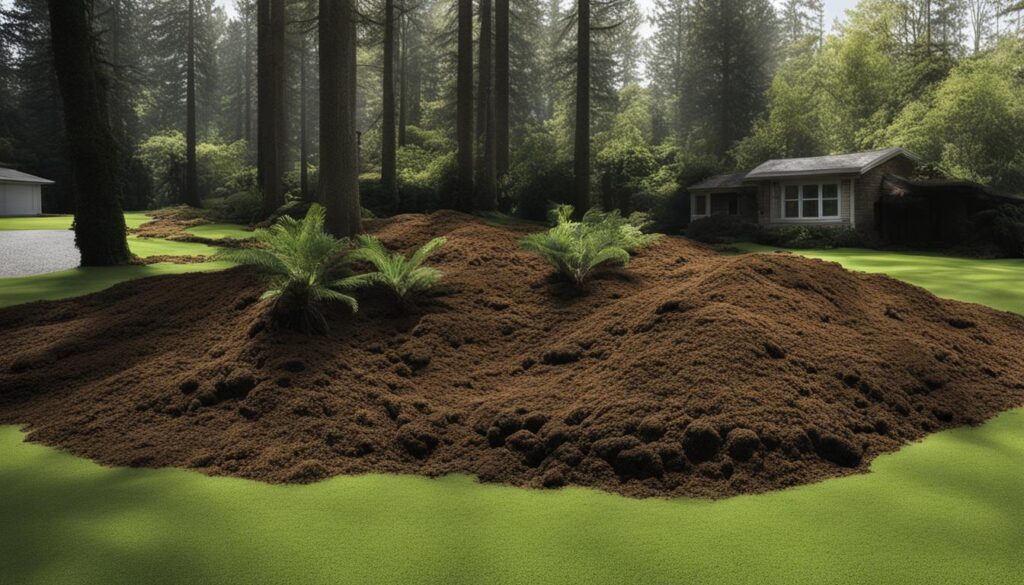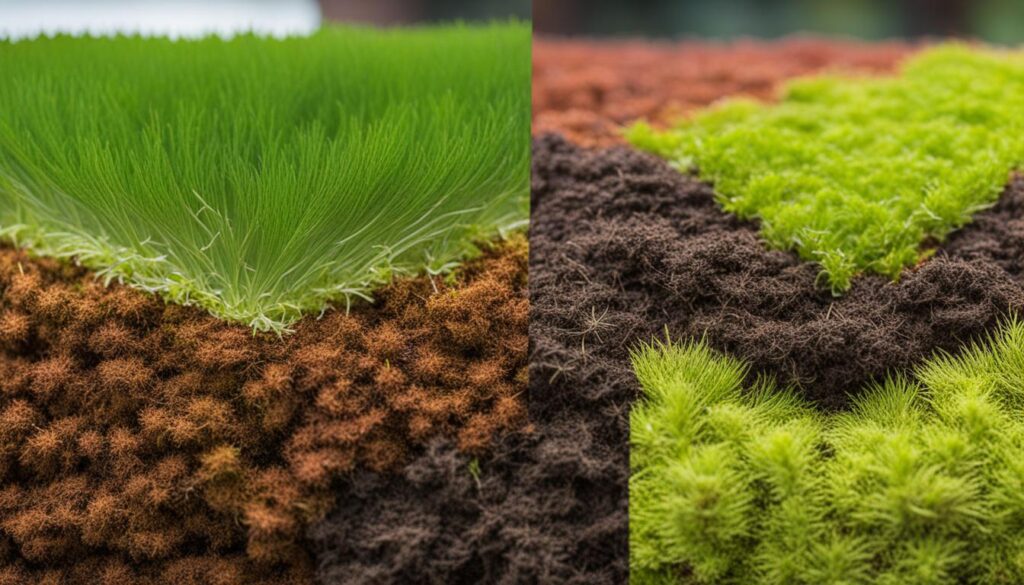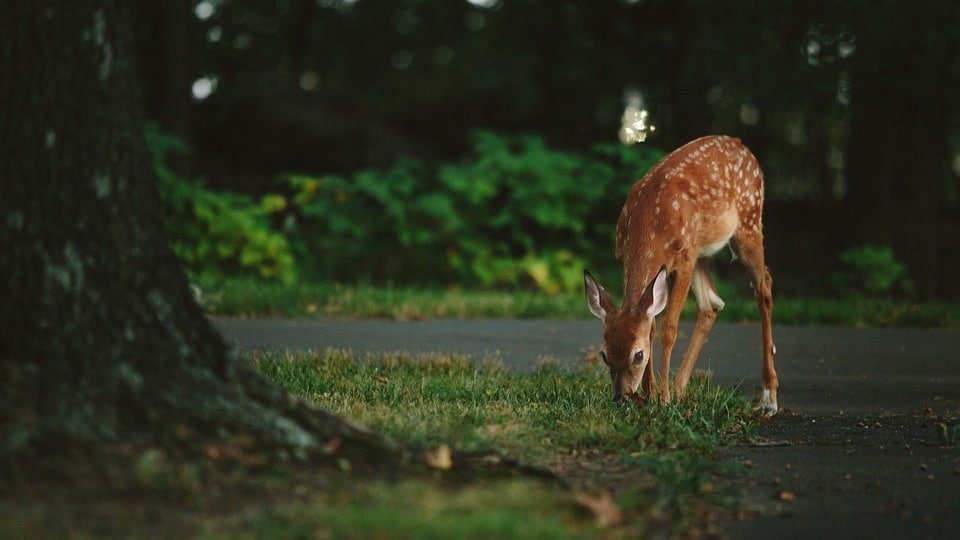Welcome to our guide on using peat moss to enhance your lawn’s topsoil. Peat moss is a valuable soil amendment that can improve moisture retention, aeration, and drainage in your lawn. By understanding how to use peat moss effectively, you can promote a healthier and more vibrant lawn.
Key Takeaways:
- Peat moss improves moisture retention, aeration, and drainage in lawns.
- It is important to consider the pH levels of your soil when using peat moss.
- Blending peat moss with other organic materials can help balance soil pH.
- A pH test before and after using peat moss is recommended.
- Peat moss is a safe and effective soil amendment for lawns.
Benefits of Peat Moss for Lawns
When it comes to enhancing the quality of your lawn, peat moss can be a game-changer. This natural soil amendment offers a range of benefits that contribute to healthier and more vibrant lawns.
One of the primary advantages of using peat moss is its exceptional moisture retention properties. It has the ability to absorb and hold water, ensuring that your lawn maintains optimal hydration levels. This means less frequent watering, saving you time and conserving water resources.
In addition to moisture retention, peat moss plays a crucial role in improving soil drainage. Its loose and fibrous structure allows water to flow through the soil easily, preventing waterlogged conditions and ensuring proper aeration for the roots of your grass.
Moreover, using peat moss helps prevent soil compaction, which can be detrimental to the health of your lawn. Its presence in the soil maintains a loose texture, allowing the roots to spread and grow freely. This prevents the soil from becoming overly compacted, which can hinder the circulation of air, nutrients, and water.
Another significant benefit of peat moss is its ability to retain and provide essential nutrients to your lawn. It acts as a reservoir, holding onto vital nutrients and preventing them from being washed away when you water your lawn. This ensures that your grass receives a steady supply of nutrients, promoting its growth and overall health.
Furthermore, peat moss is free from bacteria, fungi, and weed seeds, making it a safe choice for soil amendment. You can trust that by using peat moss, you are providing your lawn with a clean and healthy environment for optimal growth.
It’s worth mentioning that peat moss is a long-lasting soil amendment. Once applied, it continues to provide benefits to your lawn for several years, making it a cost-effective and sustainable choice.
Lastly, peat moss has an acidic pH level, making it suitable for acid-loving plants such as blueberry bushes, azaleas, camellias, hydrangeas, irises, and dogwood trees. Keep in mind that if you have neutral or alkaline soil, it’s essential to monitor and adjust the acidity accordingly to ensure the optimal growth of your lawn.
Environmental Concerns with Peat Moss
While peat moss offers numerous benefits, it’s crucial to consider its environmental impact. Peat bogs, the sources of peat moss, serve as essential carbon sinks, absorbing more carbon than they release. As a result, they play a significant role in regulating carbon dioxide levels and combating global warming. However, the process of peat bog mining for peat moss disrupts this carbon sink effect and emits carbon into the atmosphere, contributing to climate change.
Furthermore, peat bogs are considered non-renewable resources. It takes centuries for peat bogs to form, accumulating less than a millimeter in depth annually. Once these delicate ecosystems are disturbed through mining activities, they cannot be easily restored to their natural state. This depletion of peat bogs poses a serious threat to their biodiversity and the fragile balance they provide to their surrounding environments.
Considering the environmental concerns associated with peat moss, some countries, such as the United Kingdom, have taken proactive measures by banning its use in gardening. This decision reflects a commitment to sustainable practices and the preservation of vital natural resources.
Alternatives to Peat Moss
If you are concerned about the environmental impact of peat moss or simply looking for alternatives, there are several organic soil amendments you can consider.
Compost is an inexpensive and readily available option that helps retain water and nutrients while adding beneficial organic matter to the soil. It improves soil structure, increases microbial activity, and provides essential nutrients for plant growth.
Coconut coir, derived from coconut fibers, is another excellent alternative to peat moss. It has similar properties to peat moss in terms of moisture retention and soil texture. Coconut coir is a sustainable and renewable resource that promotes proper drainage and aeration in the soil.
Pine bark is a finely ground organic material that can prevent soil compaction and retain moisture. It adds texture to the soil, allowing for better root development and nutrient uptake. Pine bark is particularly beneficial for acid-loving plants like azaleas, rhododendrons, and blueberries.
PittMoss is a locally sourced and eco-friendly potting mix and soil conditioner made from recycled paper. It provides excellent moisture retention, aeration, and nutrient availability for plants. PittMoss is a sustainable alternative that can improve the health and vitality of your garden while reducing waste.
Worm castings, also known as vermicast, are the nutrient-rich organic material produced by earthworms. They improve soil structure, enhance water holding capacity, and provide essential nutrients for plant growth. Worm castings also contain beneficial microbes that aid in soil health.
Consider these alternatives to peat moss for a more sustainable gardening practice and to achieve healthy and thriving plants without compromising the environment.
Differences Between Peat Moss and Sphagnum Moss
When it comes to gardening, peat moss and sphagnum moss are often used interchangeably. However, they have distinct differences in their roles and applications. Understanding these differences can help you make informed decisions when choosing soil amendments for your garden.
Sphagnum Moss:
Sphagnum moss refers to the live moss that grows in peat bogs. It is commonly used for decorative purposes or to line baskets due to its lush, vibrant appearance. However, it is not typically used as a soil amendment for improving soil quality.
Peat Moss:
On the other hand, peat moss is derived from sphagnum moss that has been decomposing for centuries underwater. This decomposition process creates an organic material with unique properties that make it an excellent soil amendment.
Peat moss is widely used for improving soil quality, enhancing moisture retention, promoting aeration, and aiding in drainage. Its fibrous structure helps create air pockets in the soil, allowing for increased oxygen exchange. Additionally, peat moss can absorb and hold onto water, ensuring that your plants have adequate moisture.
Furthermore, peat moss acts as a reservoir for nutrients, slowly releasing them over time to nourish plants. It also helps in balancing soil pH, though it should be noted that peat moss is naturally acidic. This makes it suitable for acid-loving plants, such as blueberry bushes, azaleas, camellias, hydrangeas, irises, and dogwood trees.
By incorporating peat moss into your garden, you can improve soil structure and create an ideal environment for healthy plant growth.
Tip: Ensure you purchase high-quality peat moss to maximize its benefits. Look for reputable brands or consult with your local garden center for recommendations.
Overall, while sphagnum moss serves aesthetic purposes, peat moss is a valuable soil amendment that can significantly enhance your gardening experience. Make the most of its unique properties to create optimal growing conditions for your plants.
Where to Find Peat Moss
If you’re looking to buy peat moss for your gardening needs, there are several convenient options available to you. Most garden centers carry peat moss, making it easily accessible for both beginner and seasoned gardeners. You can find peat moss at popular big-box stores like Lowe’s and Home Depot, where it is typically sold in bags or bales. Keep an eye out for products labeled as “sphagnum peat moss,” as they are specifically formulated for optimum performance.
If you prefer to purchase peat moss in bulk, you may come across larger bricks wrapped in plastic. These bricks are perfect for larger gardening projects or if you have a larger lawn to cover. For those who prefer the convenience of online shopping, a variety of online retailers offer peat moss for sale. Simply search for “peat moss” and explore the different options available.
When purchasing peat moss, it’s essential to check the product label to ensure you are getting a quality product. Look for brands that are trusted and have a good reputation in the market. This will ensure that you are investing in peat moss that will provide the benefits you are looking for.
Note: The image above is for visual representation only and may not depict the exact product mentioned in the section.
Is Peat Moss a Good Option for Improving the Soil in Potted Plants?
Peat moss is a great option for improving the soil in potted plants. It increases water retention and provides essential nutrients for healthy potted plants with garden soil. Its acidic nature also promotes optimal pH levels. Mixing peat moss with garden soil can greatly improve the overall quality of the soil, leading to healthier potted plants.
Conclusion
Peat moss is a valuable soil amendment option for enhancing the health and vitality of your lawn. Its ability to retain moisture, improve aeration, and prevent nutrient leaching makes it a popular choice among gardeners. However, it is important to consider the environmental impact of peat moss extraction and explore alternative options.
Compost, coconut coir, pine bark, PittMoss, and worm castings are all effective alternatives to peat moss. These organic soil amendments provide similar benefits while minimizing the ecological footprint. By choosing the right soil amendment based on your lawn’s needs and considering the environmental implications, you can promote sustainability in your gardening practices.
When caring for your lawn, it is crucial to remember that healthy soil is the foundation for a beautiful and thriving lawn. Whether you choose peat moss or one of its alternatives, regular lawn care and maintenance are essential. Proper watering, mowing, and fertilizing techniques, along with regular soil testing, can help you achieve optimal results. With the right soil amendment and diligent lawn care, you can create an inviting outdoor space that you can enjoy all year round.











